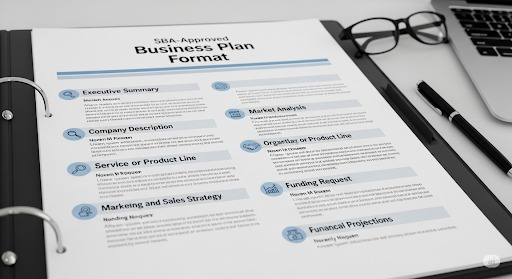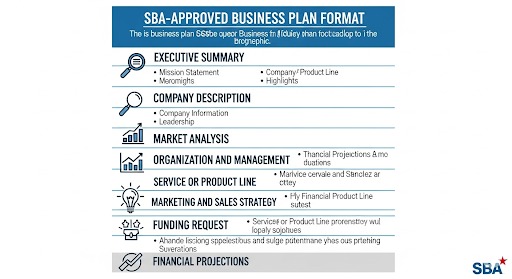Congratulations! You’ve hit peak adulthood: Googling “SBA-approved business plan,” crushed by existential dread, and clutching a cold brew you can’t afford. Forget “following your dreams”—the Small Business Administration (SBA) demands paperwork, structure, and a grown-up font. If you want an SBA loan (or just a fleeting sense of legitimacy), you’ll need to master the infamous SBA business plan format. Don’t worry—like every group project since kindergarten, you’ll be doing all the work (and your friends will still just cheer you on with emojis).
So, hustle up your best scamper-to-the-deadline energy, bribe your printer, and let’s break down the myth, mess, and misery of a “real” business plan, government-approved style.
Executive Summary: The Only Page the Bank Actually Reads (But You Still Have to Write the Rest)

Welcome to America’s favorite fiction: the executive summary.
This is the Netflix summary of your business plan—except less fun and more likely to decide your fate.
Checklist for this “vital” page:
- What’s your business? (But say it like your future depends on it. Because it does.)
- What’s your product or service? (No, “vibes” don’t count unless you’re opening a crystal shop in Brooklyn.)
- Who are you selling to? “Anyone with a pulse” is not, technically, SBA-approved.
- What’s your competitive edge? (Say “unique” and “innovative,” but don’t explain how—classic move.)
- Your dreams in numbers: projected revenue, hope, and random Excel lines pointing up.
Fake confidence is the most important ingredient. If this section reads like you have it together, the rest can just be page filler anyway.
Company Description: Insert Big Vibes and Even Bigger Promises
You thought “company description” was easy? Sorry, friend, the SBA wants your why, your how, and your tragic founder origin story—all in Times New Roman.
- Company Name: Bonus points for minimal unnecessary X’s or Z’s.
- Location: Starbucks, roommate’s mom’s garage, or somewhere less embarrassing.
- Legal Structure: LLC, C-Corp, or “whatever LegalZoom spat out.”
- History: If you started last Tuesday, say “recently established to meet emerging needs.”
- Mission Statement: Something bland like “to revolutionize coffee delivery through the blockchain”—but with less NFT and more “serious adult energy.”

Pro tip: If you can make it through this section without dry-heaving from imposter syndrome, you’re already ahead of the SBA curve.
Market Analysis: Where Googling Equals “Research Experience”
Now comes the SBA’s favorite: prove you’re not launching a product for “everyone who breathes.” Welcome to market analysis—the section where stalker skills finally pay off.
- Market size: Use at least one number you vaguely remember from a Forbes tweet.
- Target audience: Millennials who cancel plans, Gen Zers who “just vibe,” or soccer dads on TikTok—define your tribe.
- Trends: “Remote work is up 5000%” is a totally real statistic.
- Competitive Analysis: Name-drop competition, casually slam them (“unlike our outdated rivals…”), and pretend you have an edge.
- Barriers to Entry: Make yours sound higher than a PSL price hike in October.
List to seem legit:
- Statistically significant numbers (even if it’s just your follower count)
- Made-up but plausible pie charts
- A competitor table, even if it’s just “Jeff’s Sandwiches” vs. “My Sandwiches, But with Gluten-Free Mayo”
If you read this section and don’t immediately want to pivot ideas six times: did you even do the research?
Organization & Management: Time to Pretend Your Team Is Bigger Than Your Group Chat
Another SBA “must-have”—organization, management and not listing “my dog” as COO.
What (pretend) structure do you need?
- Organizational Chart: Put your name in every box, but spread it out for drama.
- Owner Information: “Founder since my entire college group project bailed.”
- Management Team: List your roommate under “Chief Snack Procurement” for giggles.
- Board of Advisors: Your cousin who once watched Shark Tank totally counts.
Honest truths:
- Most “management” is you, sleep deprivation, and whatever your freelancing designer can fix at 2 AM.
- Use as many fancy titles as possible. “Head of Synergy” is hot right now.
Remember, if it looks like a big business, maybe the loan officer will believe you’re not updating your business plan on your phone during class.
Service or Product Line: Describe What You Sell (Without Sounding Too Desperate)
The SBA demands you act like your product/service is special, even if it’s “Airbnb for left-handed podcasters.”
Checklist:
- What is it, really? “Synergistic experiences” does not count.
- Features: Make up at least two you can “roll out” in 2026.
- Life cycle: If forever is your answer, maybe shorten that.
- Research and Development: “Still Googling at midnight” is not an SBA-approved tactic.
- Intellectual Property: If you have a trademark or even a funny URL, brag NOW.
If you can’t explain your product in one sentence, rewatch every Shark Tank episode until you can.
Marketing and Sales: Manifest Your Way to “Customer Acquisition”
The SBA wants to see a plan. Investors want to see hope. You just want to go viral and never buy ads. Tragic.
- Marketing Strategy: TikTok? IG? Skywriting over Coachella? Pretend you’re strategic.
- Sales Channels: “Online, everywhere, and—optimally—markets unburdened by competition.” (Aka, Instagram DMs.)
- Customer Retention: “Loyalty program,” because everyone else does it.
- Pricing: Wild guess or “market-based” (read: what your friends will pay).
- Promotions: Seasonal, memeable, or both.
If your plan feels more like “manifesting with iced coffee,” you’re in good company.
The Money Section: Where Your Numbers Are Lies (But They’re Formatted!)
The SBA loves financials. You… do not.
Required torture:
- Funding Request: How much do you want and why? (“DoorDash, lattes, and branded hoodies” is almost enough.)
- Projections (“Financial Statements”): People want “realistic” numbers; you want to make them up. Find the middle.
- Income statement (more “income” than “statement”)
- Cash flow (you know, for when your business actually…flows)
- Balance sheet (spreadsheets and coffee stains encouraged)
- Break-even analysis: Best served with delusion.
Make your numbers pretty. Investors believe in confidence (and colored bar graphs).
The Appendix: Where Extra Stuff Goes to Hide
No Business plan is complete without a section for:
- Resumes (yours: Master Googler, Snack Timing Expert)
- Permits, licenses, leases, screenshots of enthusiastic emails
- Flowcharts (use arrows, confuse your enemies)
- Any “official” doc your future self will forget to update
Nobody will read this, but everyone expects to see it.
Conclusion: Presidential Approval Not Required (But Drama Is)
Congrats. You just survived the least fun TikTok trend ever: writing an SBA-approved business plan. Did it hurt? Obviously. But if you made it here, you’re now ready to fill in ten sections of business fiction, wear your adult pants for at least one day, and maybe—just maybe—land that tiny business loan you’ll immediately spend on branding.
If you finish without swearing at your printer, you get double points. The SBA may never know your pain, but hey, neither will your competition. Go forth, caffeinated warrior—America’s paperwork waits for no one!
